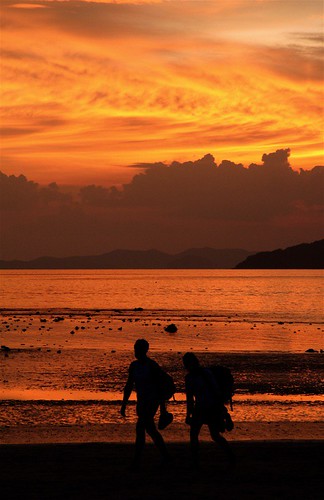 If I walked into a camera store and handled a few cameras, I would probably walk out with a Nikon D200. It looks and feels like it means business. But, when I make my 8th trip back to Nepal for trekking, I’d prefer to have my lightweight Canon 350D. We outdoor photographers have been asking for a compact, lightweight body, and we got it with the 400D/350D. Its strengths of high quality images in a lightweight and compact body come with some limitations.
If I walked into a camera store and handled a few cameras, I would probably walk out with a Nikon D200. It looks and feels like it means business. But, when I make my 8th trip back to Nepal for trekking, I’d prefer to have my lightweight Canon 350D. We outdoor photographers have been asking for a compact, lightweight body, and we got it with the 400D/350D. Its strengths of high quality images in a lightweight and compact body come with some limitations.Ergonomics
Compared to other modern bodies, the ergonomics of the 400D/350D are poor. I’m used to Nikon’s rugged, lightweight film SLRs like the FM2, which has worse ergonomics than the 400D. It had no molded grip so you couldn’t just pick up the camera with your right hand the way you can now with many modern DSLRs. I carry my Canon XT/350D the same way I carried my FM2, by cradling the lens with my left hand or lifting it up by the lens. Anyway, after a while, I think most people will get used to it, and its light weight will be a big advantage in many situations. When weight doesn’t matter, I can attach the optional BG-E3 grip, which improves the ergonomics, look and feel greatly.
Manual Mode
The camera simply isn’t set up to be used in Manual Mode. It has only one control wheel, which makes it cumbersome if you
 have to change both aperture and shutter speed manually. If you need to shoot in manual mode, you can still do it, although a different camera will probably serve you better.
have to change both aperture and shutter speed manually. If you need to shoot in manual mode, you can still do it, although a different camera will probably serve you better. This camera is excels if you are shooting in a semi-automatic mode, and it is quick and easy to adjust exposure compensation to get the results you want. I generally leave my XT/350D set at –2/3EV for higher contrast shots outdoors, maybe 0 for lower contrast indoor portraits and I’ll wind it down to –2EV to create silhouettes. Check the LCD screen to ensure you are getting the results you are after.
Metering
If you need spot metering, this camera doesn’t have it. I’ve learned to use Canon’s 35 Zone Evaluative Metering in conjunction with exposure compensation. It is not as foolproof as Nikon’s D200 Matrix Metering as the 350D Evaluative Meter is biased towards the selected AF point. So If you like to use the center AF point to focus and then recompose, you’re probably going to get some inconsistent exposures. Either use Exposure Lock or select the closest AF point to your subject and then recompose slightly.
Viewfinder
I held up a Nikon D200 to my left eye and my Canon XT/350D to my right eye to compare viewfinders. I found the viewfinder of the 350D to be slightly smaller and a little dimmer than the D200. Like everyone else, I prefer a bigger, brighter viewfinder. There’s no getting around this one, either get used to it, or get another camera.
LCD Screen
It is small and it is dim. I use maximum brightness on my LCD screen, and it is barely useable outdoors. This is quite a big limitation, as you need to use the LCD screen to change settings, like White Balance. Some guys memorize the various positions of the different White Balance settings. I prefer to leave WB in Auto (although that also has its own limitations. See my earlier post on Optimizing Your Canon Rebel XT/350D).
Power Management
The good news is that the XT/350D uses very little power. With original Canon NB-2LH batteries rated at 720mAh, I’m getting about 500 shots. I haven’t tried these, but I hear with third party batteries, rated at 1500mAh, can give up to 1000 shots per charge. Worth a try for my Nepal trip, I think.
Durability
Outdoor photographers need reliable, dependable equipment. In the wilderness, 5-days from the trailhead, there’s no store to run to pick up another camera if yours fails. That’s a big question and one to which I have no answer. DSLRs are, like all electronic equipment, fragile and highly hydrophobic. Nikon’s D200, with its weather seals and metal chassis, appears to be a more rugged and durable tool. But it is heavy. My 350D has been dropped, covered in dust, and sweated on. But it keeps on clicking. I am looking into getting a D200, but I will carry my light (and lightly built) 350D, for as long as I can.
Photos:
Top: An Artist Paints Lake Phewa in Early Morning Light, Nepal. Taken near the end of the round Annapurna Trek with a Nikon FE, 24mm lens, Fuji Slide Film
Bottom: Walking on Sunset Beach. Taken with Canon 350D, 17-85mm, Exposure Compensation -2EV.

No comments:
Post a Comment